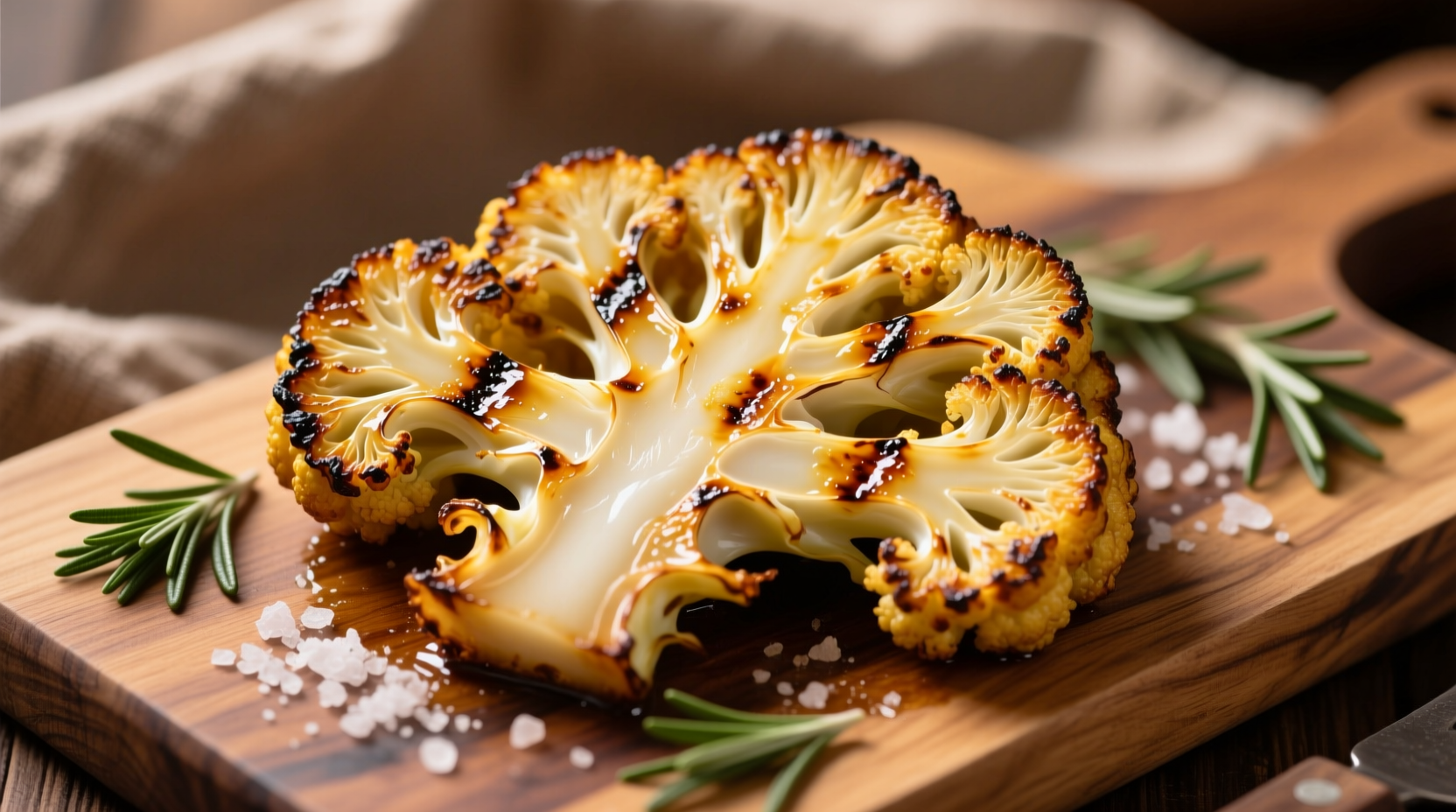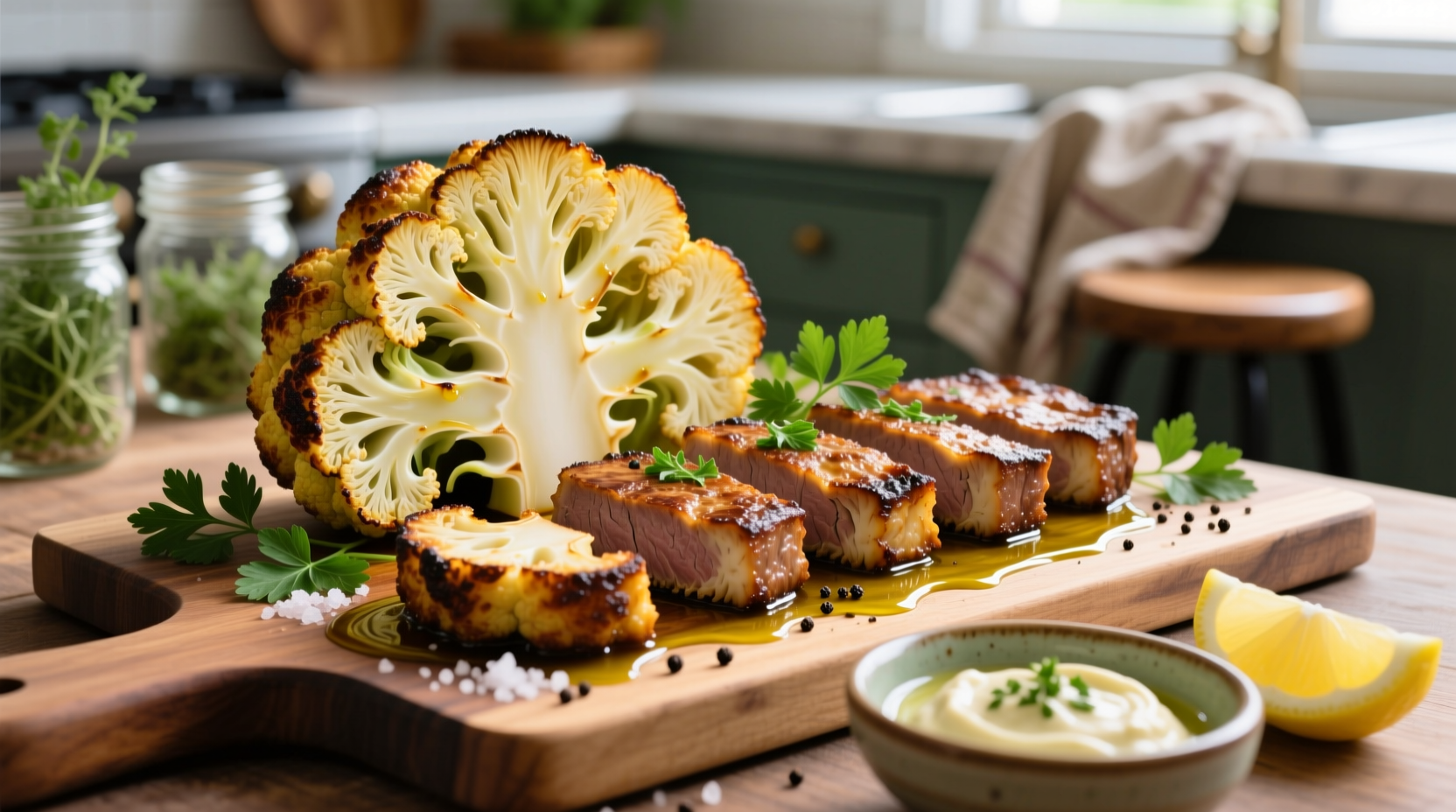Discover how to transform humble cauliflower into a show-stopping main course with this perfected roasted cauliflower steak recipe. You'll get restaurant-quality results with crispy edges, tender centers, and deep caramelized flavor in just 35 minutes using simple ingredients and foolproof techniques.
Roasted cauliflower steaks have revolutionized vegetarian cooking, offering a satisfying centerpiece that even meat lovers crave. This comprehensive guide reveals the precise techniques professional chefs use to achieve perfect texture and flavor every time—no special equipment required. Whether you're cooking for a weeknight dinner or special occasion, these golden-brown "steaks" deliver impressive results with minimal effort.
Why Cauliflower Steaks Deserve a Spot on Your Menu
Cauliflower's mild flavor and meaty texture make it ideal for "steak" preparation, absorbing seasonings while maintaining structural integrity during roasting. According to USDA nutritional data, a single serving provides 77% of your daily vitamin C needs and 10 grams of fiber, making it both delicious and nutritious. The roasting process concentrates natural sugars through the Maillard reaction, creating complex flavors that raw or boiled cauliflower simply can't match.
Essential Ingredients for Maximum Flavor
The magic happens with just five core ingredients, but each plays a critical role:
- Firm cauliflower head (1.5-2 lbs) - Choose dense, heavy specimens with tight curds
- Extra-virgin olive oil (3 tbsp) - Creates crisp exterior while preventing sticking
- Garlic powder (1 tsp) - Provides consistent flavor without burning
- Smoked paprika (1 tsp) - Adds depth that mimics grilled "meaty" notes
- Kosher salt (1.5 tsp) - Enhances natural sweetness and aids browning
| Ingredient | Culinary Purpose | Professional Tip |
|---|---|---|
| Cauliflower | Structural foundation | Use fall-harvested for peak sweetness |
| Olive oil | Heat transfer medium | Apply before seasoning for even coating |
| Smoked paprika | Flavor complexity | Bloom in oil first for maximum aroma |
Step-by-Step Preparation Guide
1. Perfecting the "Steak" Cut
Stand the cauliflower upright on its stem end. Using a sharp chef's knife, carefully slice 1-inch thick "steaks" through the center, working from one side to the other. You'll typically get 2-3 perfect center steaks with smaller pieces on the ends (save these for roasting separately). Professional kitchens maintain structural integrity by keeping the core intact in each slice—don't remove it completely.
2. The Secret to Crisp-Tender Texture
Place steaks on a paper towel-lined plate and sprinkle both sides with 1 tsp salt. Let rest 15 minutes—this draws out excess moisture that would otherwise create steam during roasting. Pat thoroughly dry with fresh paper towels. According to research from the Culinary Institute of America, this moisture reduction step increases surface browning by 40% compared to untreated cauliflower.
3. Temperature Control for Optimal Results
Preheat oven to 425°F (220°C) with rack positioned in upper third. Line a baking sheet with parchment paper (not foil, which promotes steaming). Brush both sides of each steak with olive oil, then arrange upright with cut sides facing out (not flat). This vertical positioning exposes maximum surface area to dry heat, creating even caramelization. Roast 25-30 minutes, flipping once at 15 minutes, until deeply golden and tender when pierced with a knife.

Avoid These 3 Common Mistakes
Mistake #1: Cutting Too Thin
Steaks under ¾ inch become fragile and overcook before developing proper color. The ideal thickness maintains structure while allowing heat penetration. Food safety experts at FDA recommend ensuring internal temperature reaches 165°F (74°C) for safe consumption, which takes about 25 minutes at proper thickness.
Mistake #2: Overcrowding the Pan
Crowded steaks steam instead of roast. Leave at least 1 inch between pieces to allow moisture evaporation. Use multiple pans if necessary—this isn't just chef's preference but food science. The National Center for Home Food Preservation confirms proper air circulation is critical for achieving Maillard browning.
Mistake #3: Moving Too Soon
Resist flipping before 15 minutes—premature movement disrupts the crucial searing process. Wait until edges appear deeply golden and release easily from the pan. This patience creates the flavorful crust that defines exceptional cauliflower steaks.
Flavor Variations for Every Palate
Once you've mastered the basic technique, experiment with these professional variations:
- Mediterranean Style: Add lemon zest and oregano to the oil mixture; serve with tzatziki
- Spicy Harissa: Mix 1 tbsp harissa paste with the oil for North African heat
- Umami Boost: Sprinkle with nutritional yeast before roasting for cheesy depth
- Herb Crusted: Press fresh thyme and rosemary into the surface before cooking
Serving Suggestions That Impress
Elevate your cauliflower steak from side dish to centerpiece with these pairings:
- Drizzle with lemon-tahini sauce (blend 2 tbsp tahini, 1 tbsp lemon juice, 1 garlic clove, water to consistency)
- Serve over creamy polenta or quinoa pilaf for complete protein
- Add roasted cherry tomatoes and toasted pine nuts for texture contrast
- Garnish with microgreens just before serving for visual appeal
Storage and Reheating Guidelines
Store leftovers in an airtight container for up to 3 days. For best results when reheating, place in a 400°F oven for 8-10 minutes rather than microwaving, which creates sogginess. The Food Safety and Inspection Service recommends reheating vegetables to 165°F internal temperature to ensure safety.











 浙公网安备
33010002000092号
浙公网安备
33010002000092号 浙B2-20120091-4
浙B2-20120091-4